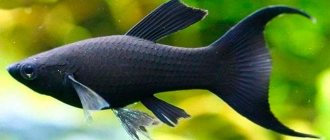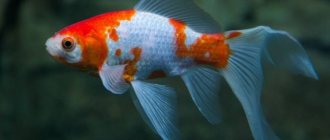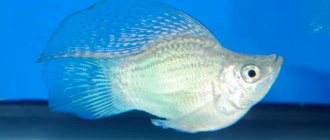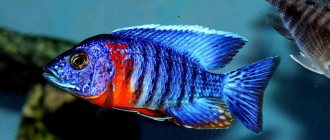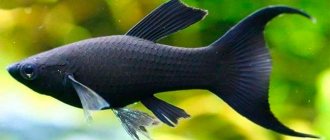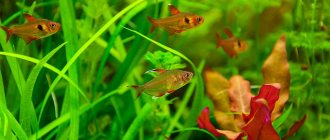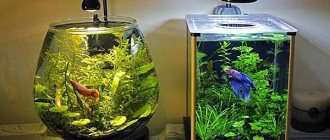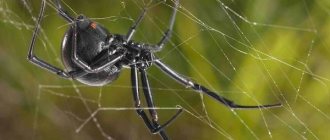Home › Aquarium fish ›
Your rating will be the first!
Solid black color is quite rare among freshwater aquarium fish, and virtually none of the black aquarium fish species are found in nature in their pure form. Domestic aquatic animals were able to obtain this color only through selection. Several titles with photos and general information.
Black molly
This aquarium fish can confidently be called the black queen of the home aquarium.
These are the most famous black aquarium fish, the most popular and widespread. In addition, they are inexpensive and quite easy to keep, and the offspring of these fish are born with enviable regularity and are fully formed - molly fish are viviparous fish. In nature, mollies are not found in solid black color; this color was obtained through inbreeding. There is both a regular form and a lyretail - with a tail with elongated edges, shaped like a lyre, as well as a disk form - the body is rounded and distorted, shaped like a balloon.
Reproduction
Breeding labeo fish at home is a difficult task. This is done by specialists in Southeast Asia or local professional aquarists.
Sex difference
It is quite difficult to distinguish a female from a male. Up to a year there is no difference between them. In adulthood, sexual dimorphism is weakly expressed: females have a lighter, rounded abdomen.
When it is necessary to determine the sex of a labeo fish, spawning-stimulating operations are carried out.
Stimulating injections
Natural spawning occurs rarely. To stimulate the process, it is customary for aquarists to carry out hormonal injections.
Without experience and certain skills, it is difficult to make high-quality injections. A dosage error will be fatal.
The injection is given with a thin insulin syringe between the scales on the back.
Popular stimulation schemes:
- The first injection - human chorionic gonadotropin (replaced by Pregnil) is given only to females. The dose is calculated based on the weight of 5–10 mg per 1 g of fish weight; a day later, a second injection is a suspension of the pituitary gland of carp fish dehydrated in acetone - 0.2 mg per 10 g weight for females and 0.1 mg per 10 g weight for males.
- Injection of a suspension of the pituitary gland into a female at the rate of 0.03 mg of the substance per 10 g of body weight, after 24 hours, injection into the female and male at 0.3 mg per 10 g of body weight.
The composition is sold only at fish farms. After spawning, add an antibiotic to the water to prevent infections.
In addition to the described schemes, a less dangerous method is also used, but does not provide a 100% guarantee of spawning. The drug "Nerestin" is administered using a syringe or added to food. It is non-hormonal and sterile; there is no need to add antibiotics after its use.
Before injections or “spawning” fish of different sexes, keep them separately for two weeks.
Male shortage
Labeo bicolor has few males in the litter. To obtain the required number of boys, the fish are bred in large sizes. The situation is complicated by the faster growth of females, as a result of which, when dividing the territory, males often lose and die.
Place the most clogged fry in more comfortable conditions. Most often these babies are male.
Preparation for spawning and spawning
Adulthood and readiness to spawn occurs at the age of 1.5 years. Take 2-3 males for one female.
Before spawning, the fish are fed more often and more. Change the water regularly. After the injections, the pets are placed in an oval-shaped spawning tank. Volume from 150 liters, height about 40 cm.
Reduce water hardness to 1.5-2.5.
You cannot lower your temperature after hormonal injections. This is deadly for fish.
Good aeration is maintained in the spawning tank. A pump is needed to ensure a water flow of about 40 m/s.
Plant the container with moss and plants to relieve your pets of stress.
Spawning lasts about half an hour in three stages. Productivity is 3–15 thousand eggs with a diameter of 1.5 mm. Half an hour after spawning, adults are removed. The pump is turned off, the flow necessary for the eggs is maintained by aeration.
Development of labeo fry
This fish is a pegalophile. The eggs ripen in suspension and not on the bottom, which prevents them from being eaten by their parents. The fry mature in 15 hours, after 24 they begin to move and look for food. At this stage of life, pollen from ground particles of algae and ciliates is suitable.
Gradually introduce egg yolk into the diet, and after 7–10 days the finished zooplankton. Such food is sold in specialized pet stores.
Black Moor or telescope
This is one of the types of goldfish, also quite famous and popular. This is a type of telescope, but black in color, with less prominent cone-shaped eyes and quite small in size compared to other types of golden ones (about 10 cm). This species is classified as a “disabled” goldfish - due to its overly protruding eyes, the fish have poor vision, and the eyes themselves are very susceptible to infections. The fry are dark bronze in color, only the adult fish turn black. Also, with age, the black color becomes paler, even gray.
In addition to the black telescope, other types of goldfish can be found in black: comets , veiltails .
Content
Black mollies are considered an unpretentious fish, but they are more demanding than other types of platies in terms of living conditions. Sensitive to temperature conditions. Prefers hard, clean water. Air purging is desirable, filtration is required.
Provide a lighted swimming area in the center of the container. Place shelters in the form of plants or stones, snags, grottoes.
Don't keep molly alone. The ideal option is 1 male for 3 females. Reduces male hostility.
Aquarium size
Provide a spacious aquarium: from 15 liters per couple in a common aquarium. From 50 liters when keeping a flock of 3 individuals separately. Mollies do not tolerate acidic environments.
Water parameters
- Water temperature: 23–28° When the temperature drops below 21°C, they are little active and do not grow. The color fades.
- Hardness: 5–20 °F.
- Acidity: pH 7.5–8.5.
If acceptable for other inhabitants, mix in sea salt: 2–4 grams per liter (2–4‰). A heaped teaspoon contains 10 g, without it - 7 g. Other inhabitants will not like the saltiness.
To maintain acidity standards, change 1/4 of the water volume weekly. Old water becomes acidic.
Plants
Mollies tend to eat soft plant foliage. Give preference to greens with rough leaves.
- Vallisneria can withstand salinity up to 20‰.
- Stiffleaf arrowhead (sagittarium).
- Java moss is a ready refuge for fry.
- Riccia grows faster than it can be eaten.
- Elodea floats in the water column or is fixed. They won’t have time to eat it: it will grow back and will have to be cut.
- Indian fern (water cabbage).
Fry and females hide in dense thickets during spawning.
Priming
Doesn't matter. But black molly looks good against a light background.
View this post on Instagram
Posted by AQUAFANATIC (@_aquafanatic_) Nov 9, 2021 at 1:47 PST
Decorative elements
Stones and driftwood serve as a refuge for fish. Females rest behind them from the activity of males.
Treat snags with caution. Incorrectly prepared, lower pH.
Optional equipment
- Compressor with sprayer. Air blowing will be needed in an overcrowded aquarium and when there is a lack of plants. The productivity for aeration is from 0.8 liters of air per hour per 1 liter of water.
- An internal filter is suitable for containers up to 150 liters. With connection to a compressor. Otherwise - external. Pumping capacity is required from 8 volumes per hour. The current created is familiar to mollies.
- Siphon for cleaning the bottom from food debris and waste.
- Heater equipped with a thermostat. For large aquariums, a submersible horizontal ground one is convenient. Does not need to be turned off when changing water.
- Thermometer.
- Scraper for removing algae from front glass. There is no need to clean the back and sides if there are no decorations. Black molly eats green growths with pleasure.
- Net with frame from 4".
Lighting
The backlight is bright, the luminous flux is 80–100 lumens per liter. Choose LED and fluorescent light sources with a color temperature of 5000 K. The lamps are energy saving. The aquarium does not heat up.
Daylight hours are 11–13 hours.
Aquarists recommend 2-3 hours of natural light and sunlight per day. The benefits of “tanning” are not justified. But algae infestation is guaranteed. Some of the parasites will be eaten by mollies. But not all types of unwanted vegetation cannot cope with the rapid growth of weeds.
The active growth of algae is provoked by ultraviolet radiation and the presence of nitrites and ammonia in the water.
Guppy Black Prince
One of the many fancy varieties of guppies, stunningly beautiful aquarium fish, but not completely black. The front of the male's body is silvery-gray, the back of the body, fins and tail are deep black, with possible lighter spots. The female is typically silver with a black rear and tail. Another variety is Black Monk - the fish are completely black, with a blue tint visible in strong lighting. The abdomen of males is silvery, females are silvery with a black tail. This variety was almost lost, but breeders are trying to revive it. There are two other varieties with partial coloring: black-tailed tuxedo and panda.
Cichlids
Cichlids are small aquarium aggressors. These fish terrorize other inhabitants of the aquarium and are almost always better off living only in their own school.
Arapaima and arowana are also considered aggressive fish.
A spacious aquarium with room temperature and additional lamp lighting will suit them as a home. These representatives of cold-blooded animals love food, as well as worms.
Did you know? A feature of this “breed” is an increased maternal instinct. Cichlids are incredibly caring for their offspring, which is not usually the case with the fish family.
Black angelfish
There are three black angelfish phenotypes. The Black Hybrid is an impressively beautiful variety of the common angelfish, creamy black in color, a hybrid of the dark, marbled and golden angelfish. The highest grade will be an extremely rich black; lower class may show black bars. Double dark black - the color of soot, the stripes are visible only when illuminated. Black lace - the body of the fish is the color of charcoal, the stripes are clearly visible; tail and fins with a lace pattern. The stripes may darken or disappear depending on the mood of the fish.
The fry of these varieties are usually light gray in color.
Instead of an afterword
The beauties discussed above instantly attract the eye. If you decide to decorate your aquarium in a minimalist style, then black fish and artificial white soil will be an excellent, effective solution. Fortunately, dozens of varieties of black aquarium fish have now been bred.
Sources:
https://fb.ru/article/254136/ryiba-chernaya-foto-i-opisanie-samyih-populyarnyih-obitateley-akvariuma
https://www.inthewater.ru/akvariumnie-rybi/mollineziya-chernaya/
https://blog.tetra.net/ru/ru/mollineziya-chernaya-cheshuya-cveta-uglya
Black betta cockerel
Wild bettas have black pigmentation, but other colors usually cover the black. The entire body is covered with black pigment, except for the caudal fin and belly area. Breeders have obtained several black varieties of cockerels, and here are just the most popular:
- Black Melano is the most popular of the black varieties. The fish are a dense dark black color, often blue-black (raven-wing color). To obtain offspring, this species is crossed with colored varieties, since the male and female black melano produce non-viable offspring.
- Black lace is a dark red fish, very rarely acquires a color like black melano.
- Black Orchid - dark black with streaks of steel blue in the fins, often forming an almost butterfly pattern; Black Devil - with red tints; Black ice - with shades of steel, royal or green.
- Copper-based black (newest trend) - unlike melano, the females of this variety are fertile.
Labeo bicolor or two-color
A medium-sized aquarium fish, 12-15 cm, velvety black in color, with black fins and a red tail. Labeo can add a special touch to any large aquarium with lots of live plants. The completely black relative of this species, Labeo black , is a very large fish, 40-90 cm in length, so it is not suitable for keeping in most aquariums.
Aquarium fish zebrafish photo
A small decorative fish for an aquarium. She is easy to care for and not aggressive. Danios live in small schools of 6 pieces. The homeland of the fish is South Asia. There they live in a body of water with shallow currents and swim in large schools. The largest concentration of these fish is near plants.
Both male and female Danios are brightly colored and have a small, elongated body. It gives the impression that they are porcelain and fragile. There are several species of Danio. It is better to look at what these aquarium fish look like, photos with names for beginner aquarists on the Internet. When you go shopping for fish, you will already know what they look like.
Danio rerio maintenance and care
Danios can live in a small aquarium. This is what is attractive about them, because not everyone has the opportunity to install a huge container at home. The aquarium is planted with green plants and algae. Don't forget to leave some free space for the fish to frolic.
Sea greens need light, so it is better to place the aquarium in a bright place. Danios are not picky about temperature; a range from 15 to 30 degrees Celsius will be sufficient. If you need the fish to reproduce, the water temperature should be no higher than 22 degrees Celsius. In addition, it will be necessary to periodically do aeration. During the period of active reproduction and growth of fry, the usual dose of oxygen may not be enough.
How to feed zebrafish in an aquarium
Danio eats dry, live or combined food. Live cyclops, small crustaceans plankton and daphnia work well. You can give live bloodworms and other foods that tend to sink to the bottom of the aquarium. Dry food is rich in vitamins, but it still needs to be diluted with live food. Sometimes these fish feed on bacteria and algae that they find in the aquarium.
In general, the Danio species is perfect for those who are just starting to breed fish.
